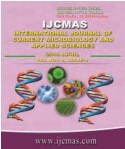


 National Academy of Agricultural Sciences (NAAS)
National Academy of Agricultural Sciences (NAAS)

|
PRINT ISSN : 2319-7692
Online ISSN : 2319-7706 Issues : 12 per year Publisher : Excellent Publishers Email : editorijcmas@gmail.com / submit@ijcmas.com Editor-in-chief: Dr.M.Prakash Index Copernicus ICV 2018: 95.39 NAAS RATING 2020: 5.38 |
Ecological niche modelling or Predictive habitat distribution modelling framework for Sesamum mulayanum Nair, an important wild relative of oilseed crop Sesame has been analyzed using Maximum Entropy method. Based on the Ecological Niche model generated using the presence points only from Maharashtra state, potential states identified for the distribution wild sesame species (S. mulayanum) in India are Andhra Pradesh, Chhattisgarh, Karnataka, Kerala, Goa, Gujarat, Madhya Pradesh and Maharashtra. These states of India could be targeted for future exploration missions based on climate suitability and for identifying in-situ conservation areas to conserve this important wild species. In-situ assessment of morphological traits viz., plant height, no. of ramifications, length of lower leaves, width of lower leaves, length of upper leaves, width of upper leaves, root length, root shoot ratio, corolla length, corolla width, petiole length lower leaves, petiole length upper leaves, first Internode length, second internode length, capsules per plant, seeds per capsule, capsule length and width indicated good variability exists among wild accessions of S. mulayanum. Results of the physiological traits studied viz., chlorophyll content index (CCI), photosynthetically active radiation (PAR) and leaf area index (LAI) are also presented in this paper.
 |
 |
 |
 |
 |